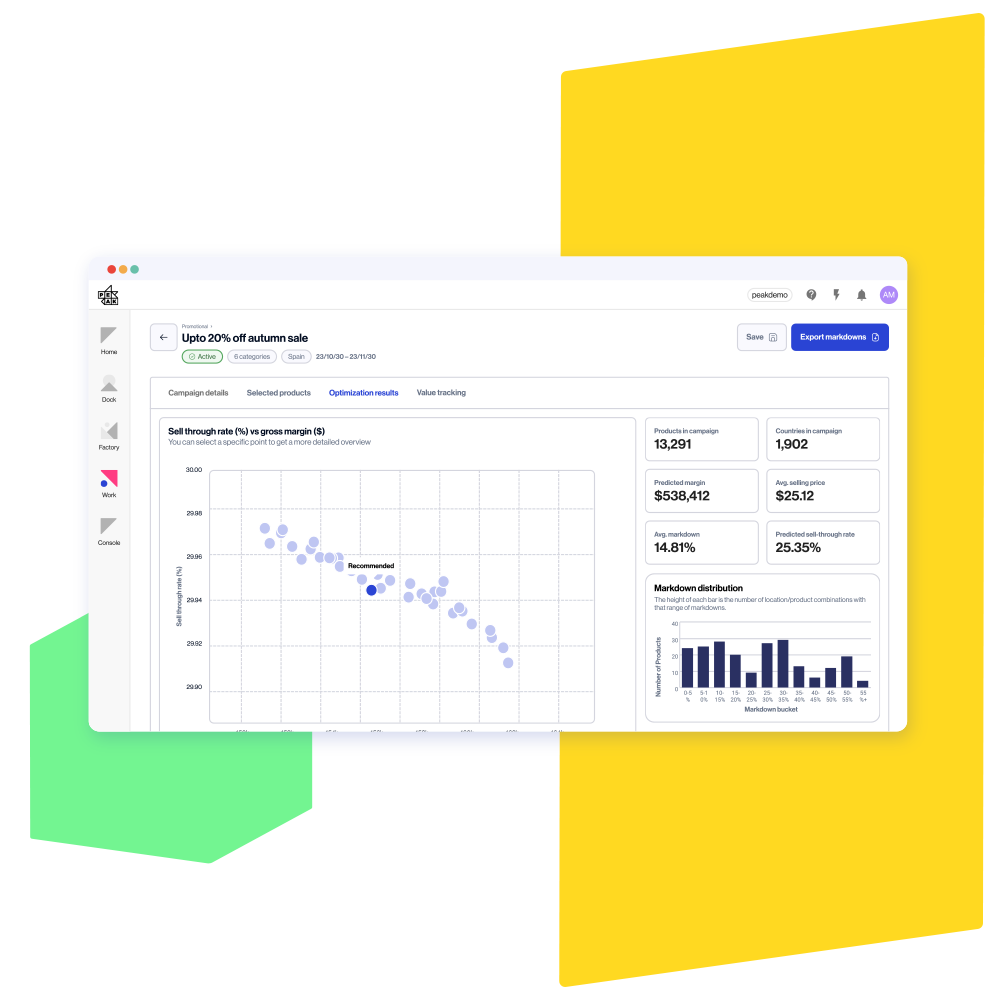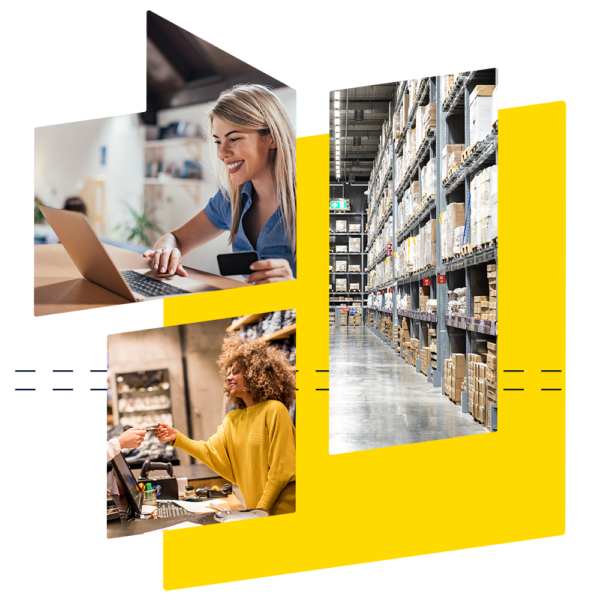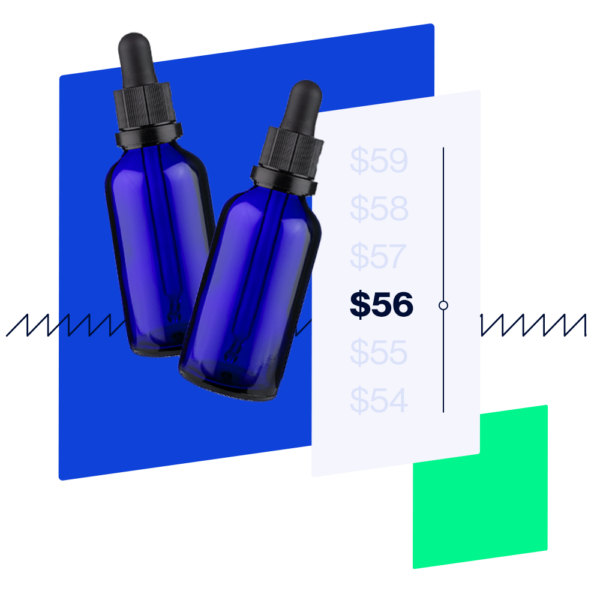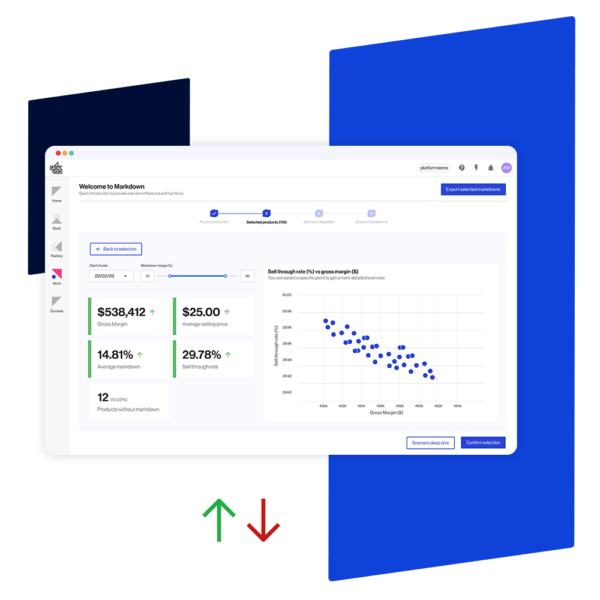
Pricing AI | Promotions
SKU-level promotional planning
Maximize sales across channels without compromising on margin with Pricing AI’s retail promotion optimization capabilities

Stop leaving cash on the table with ad hoc promotions
Retailers spend over $1 trillion on promotional programs (BCG), but rarely understand their impact on bottom line or customer experience. Peak’s retail promotion optimization software lets you explore promotional strategies and choose the winning combination of discount, timing and customer profile — so you can stop leaving profit on the table and start using promotions to grow revenue strategically.
Use AI for price and promotion optimizations and improve over time
With the power of AI, you can learn from each promotion and apply those learnings to the next one. Peak’s price and promotion optimization software processes the results from all of your transactions to analyze incrementality, cannibalization and other effects on your sales.
Retail promotion optimization, at scale
-
Maximize sales whilst increasing margin
-
Profitably sell through clearance stock
-
Reduce manual decision making and save time
-
Integrate with seamlessly with existing systems
Under the hood
Pricing AI applies AI models to your inventory, transaction and pricing data, taking into account business-specific targets and constraints, to provide you with SKU-level promotion suggestions for any location or channel.
- Application users
- Features & benefits
- Actions & results
See Pricing AI for promotions in action

Retail markdown: controlling margin | Key takeaways from our virtual roundtable

Leveraging an AI ‘nervous system’ to reimagine retail pricing
FAQs
What is retail promotion optimization?
Retail promotion optimization (RPO) is a strategic approach used by retailers to maximize the effectiveness of promotional activities and enhance overall sales performance. This optimization process involves the analysis, planning and fine-tuning of promotional strategies to ensure they align with business goals, engage customers and drive revenue.
Key components of retail promotion optimization include:
- Data analysis: Retailers leverage data analytics to assess historical sales data, customer behavior and market trends. This analysis helps identify patterns, preferences and the success of past promotions.
- Forecasting and planning: Using insights from data analysis, retailers forecast the potential impact of different promotional strategies. This involves predicting how specific promotions will influence customer purchasing behavior and adjusting inventory levels accordingly.
- Segmentation and targeting: Retail promotion optimization involves segmenting the target audience based on factors such as demographics, buying habits and geographic location. Tailoring promotions to specific customer segments increases relevance and effectiveness.
- Multi-channel integration: Successful retail promotion optimization considers a multi-channel approach, integrating promotions across various platforms such as online, in-store and mobile. This ensures a consistent and seamless customer experience.
- Dynamic adjustments: In a dynamic retail environment, continuous monitoring and adjustments are crucial. Retailers may use real-time data to adapt promotions based on changing market conditions, customer feedback or unexpected events.
- Performance measurement: Retailers assess the success of promotions through key performance indicators (KPIs) such as sales lift, return on investment (ROI) and customer engagement. This feedback loop informs future optimization efforts.
Implementing retail promotion optimization not only maximizes sales but also improves customer satisfaction and loyalty. It allows retailers to allocate resources effectively, reduce excess inventory and build stronger connections with their target audience.
In conclusion, retail promotion optimization is a strategic and data-driven approach that empowers retailers to refine and enhance their promotional strategies, ultimately driving business success in a competitive market landscape.
Why do retailers need promotion optimization?
Retailers need promotion optimization to strategically enhance their promotional activities and achieve maximum impact on sales and overall business performance. This systematic approach is crucial in today’s competitive market for several compelling reasons:
- Maximizing ROI: Promotion optimization allows retailers to allocate resources effectively, ensuring that promotional activities generate the highest possible return on investment (ROI). By fine-tuning strategies based on data-driven insights, retailers can optimize spending and maximize revenue.
- Meeting customer expectations: Consumers today have diverse preferences and high expectations. Promotion optimization enables retailers to tailor their promotional efforts to specific customer segments, ensuring relevance and resonance. This targeted approach increases the likelihood of customer engagement and satisfaction.
- Minimizing excess inventory: Effective promotion optimization involves aligning promotions with inventory levels. By accurately forecasting demand and strategically planning promotions, retailers can minimize excess inventory, preventing overstock situations that tie up capital and resources.
- Staying competitive: In a dynamic retail landscape, staying ahead of the competition is crucial. Retailers that continuously refine and optimize their promotional strategies are better positioned to adapt to market changes, capitalize on emerging trends and outperform competitors.
- Enhancing customer loyalty: Well-executed promotions contribute to a positive customer experience. By delivering value through promotions that resonate with the target audience, retailers can build trust and foster long-term customer loyalty. Satisfied customers are more likely to repeat purchases and recommend the brand to others.
- Data-driven decision-making: Promotion optimization relies on data analytics to inform decisions. Retailers can leverage data insights to understand customer behavior, assess the success of past promotions and forecast future trends. This data-driven approach empowers retailers to make informed and strategic decisions.
- Adapting to market dynamics: Markets are subject to constant change, influenced by factors such as seasonality, economic conditions and emerging trends. Promotion optimization enables retailers to adapt quickly to these dynamics, ensuring that promotional strategies remain effective and aligned with current market realities.
In summary, retailers need promotion optimization to navigate the complexities of the modern retail landscape. This strategic approach not only drives sales and customer satisfaction but also positions retailers to thrive in an ever-evolving market.
What are the challenges facing retail promotion optimization?
Retail promotion optimization, while highly beneficial, comes with its share of challenges that retailers must navigate to ensure successful implementation. These challenges include data complexity, dynamic market conditions and integration across channels. Let’s take a closer look at these challenges and more:
- Data complexity: Managing and analyzing vast amounts of data can be overwhelming. Retailers often face challenges in consolidating data from various sources, ensuring its accuracy,and extracting actionable insights for effective promotion optimization.
- Dynamic market conditions: The retail landscape is subject to rapid changes influenced by factors such as seasonality, consumer trends and economic conditions. Adapting promotions to these dynamic conditions requires agility and a proactive approach to stay ahead of the competition.
- Integration across channels: Coordinating promotions seamlessly across multiple channels, including online and offline platforms, poses a challenge. Ensuring a consistent brand message and customer experience requires effective integration and coordination.
- Understanding customer behavior: Predicting and understanding consumer behavior accurately is complex. Retailers face challenges in segmenting their diverse customer base and tailoring promotions to meet the specific preferences and expectations of different audience segments.
- Balancing inventory levels: Striking the right balance between maintaining optimal inventory levels and preventing stockouts or overstock situations is a constant challenge. Failure to align promotions with inventory management can lead to missed sales opportunities or excess inventory costs.
- Competition and pricing pressures: The competitive nature of the retail industry puts pressure on pricing strategies. Retailers must optimize promotions to offer competitive prices while maintaining profitability, which can be challenging in price-sensitive markets.
- Technology implementation: Adopting and integrating advanced technologies for promotion optimization may pose challenges, especially for smaller retailers with limited resources. Overcoming technical barriers and ensuring the smooth operation of new systems is crucial for successful implementation.
- Measuring effectiveness: Evaluating the success of promotions and accurately measuring key performance indicators (KPIs) can be challenging. Retailers need to establish meaningful metrics and use analytics tools to assess the impact of promotions on sales and customer engagement.
- Consumer fatigue: Overexposure to promotions can lead to consumer fatigue, where customers become less responsive to repeated discounting strategies. Retailers must find a balance between offering promotions and maintaining a sense of exclusivity to avoid diminishing returns.
- Regulatory compliance: Adhering to regulations and compliance standards in various regions poses a challenge for retailers operating in diverse markets. Ensuring that promotions comply with legal and industry standards is essential to avoid legal issues.
Despite these challenges, retailers can overcome them by adopting a proactive and strategic approach to promotion optimization. By leveraging advanced analytics, staying informed about market trends and implementing agile promotional strategies, retailers can navigate the complexities of the industry and drive sustainable business growth.




